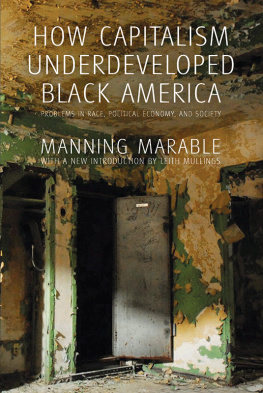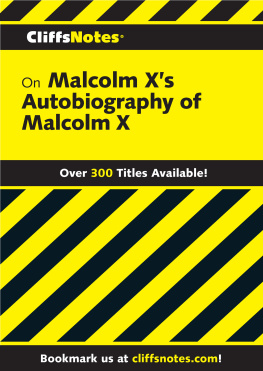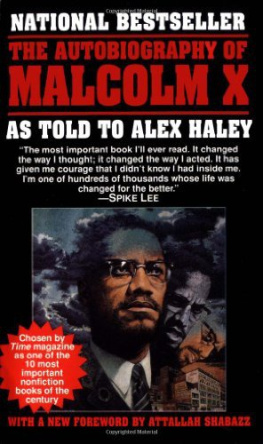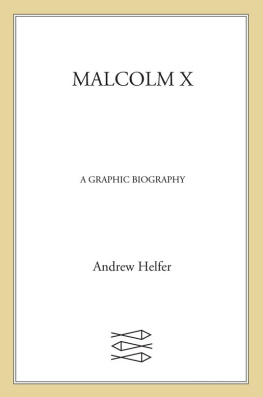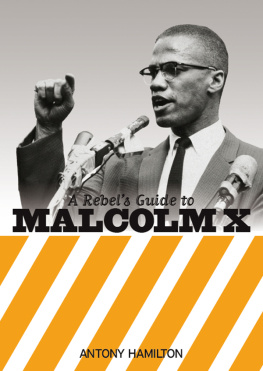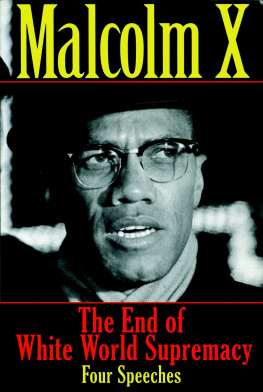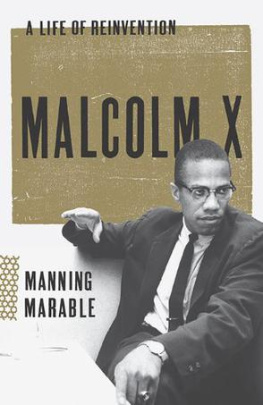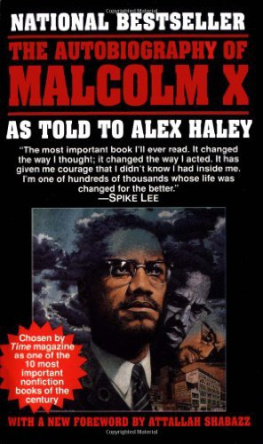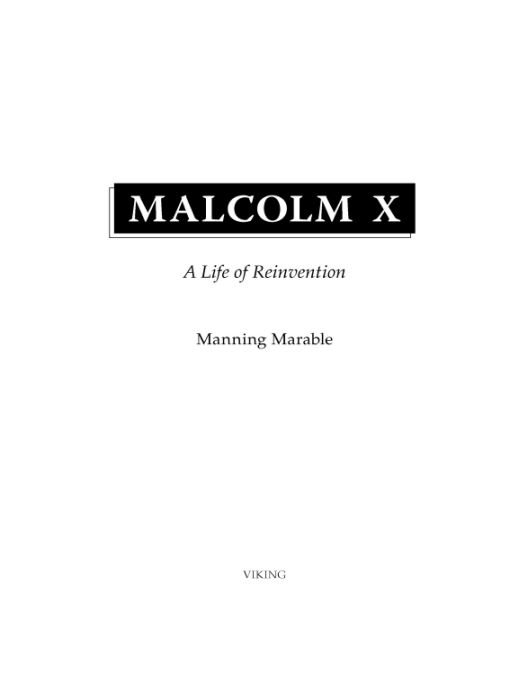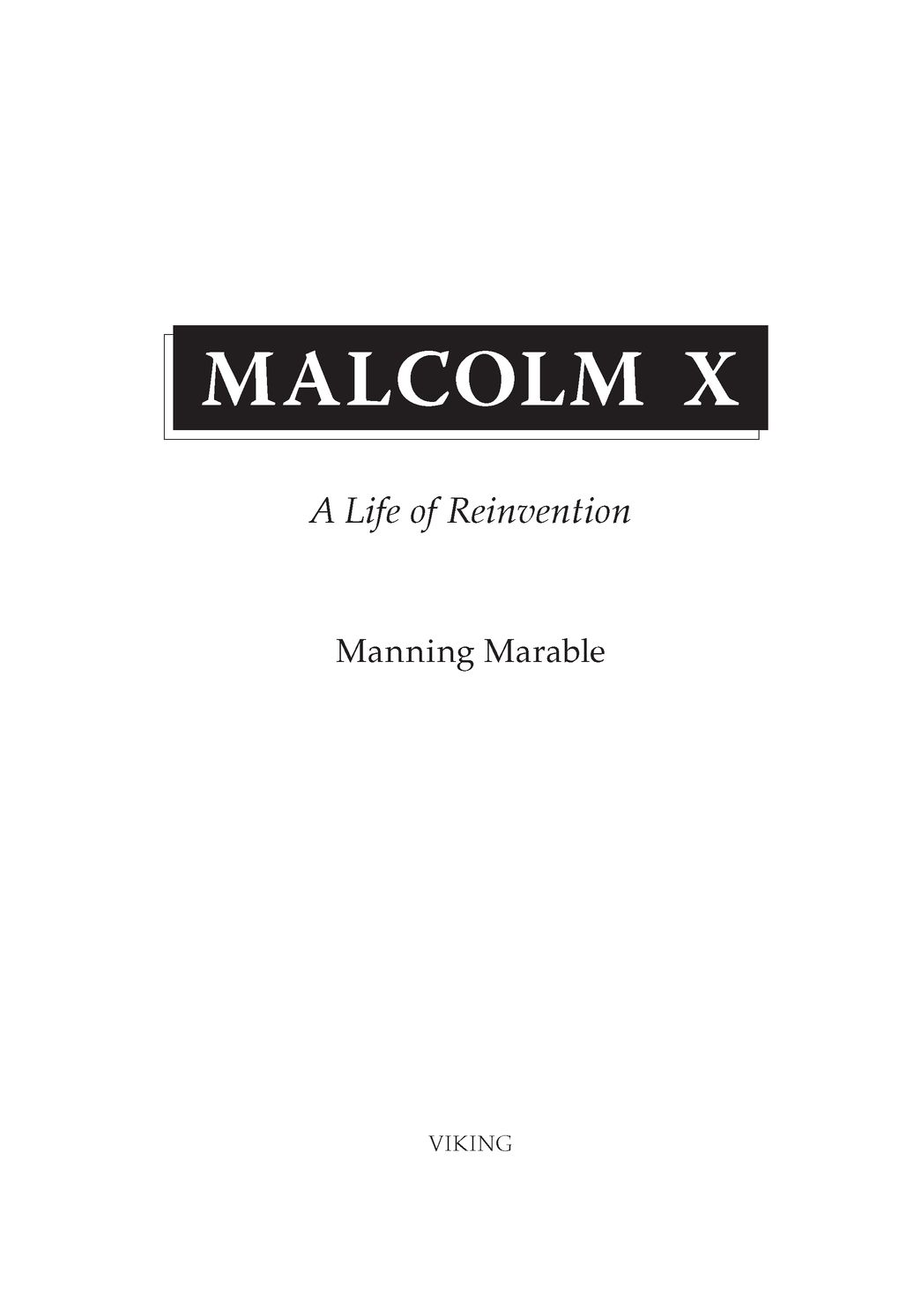Contents
ALSO BY MANNING MARABLE
Barack Obama and African-American Empowerment (edited with Kristen Clarke)
Let Nobody Turn Us Around: An African-American Anthology (edited with Leith Mullings)
Transnational Blackness: Navigating the Global Color Line (edited with Vanessa Agard-Jones)
Living Black History: How Reimagining the African-American Past Can Remake Americas Racial Future
Race, Reform, and Rebellion: The Second Reconstruction and Beyond in Black America, 19452006
W. E. B. Du Bois: Black Radical Democrat
Seeking Higher Ground: The Hurricane Katrina Crisis (edited with Kristen Clarke)
The Great Wells of Democracy: The Meaning of Race in American Life
Freedom: A Photographic History of the African-American Freedom Struggle (coauthored with Leith Mullings)
Black Leadership
Black Liberation in Conservative America
Speaking Truth to Power: Essays on Race, Radicalism, and Resistance
Racializing Justice, Disenfranchising Lives (edited with Keesha Middlemass and Ian Steinberg)
Herbert Aptheker on Race and Democracy (edited with Eric Foner)
The New Black Renaissance: The Souls Anthology (editor)
Beyond Black and White: Transforming African-American Politics
The Crisis of Color and Democracy
African and Caribbean Politics
Black American Politics
How Capitalism Underdeveloped Black America: Problems in Race, Political Economy, and Society
The Autobiography of Medgar Evers (edited with Myrlie Evers-Williams)
Freedom on My Mind: The Columbia Documentary Experience of the African-American Experience (editor)
Dispatches From the Ebony Tower: Intellectuals Confront the African-American Experience (editor)
Blackwater: Historical Studies in Race,
Class Consciousness, and Revolution
No one has made more sacrifices to realize the completion of this
work than Leith Mullings. For more than a decade, she has been
my constant companion and intellectual compass as I have
attempted to reconstruct the past.
This work is hers.
PROLOGUE
Life Beyond the Legend
In the early years of the last century, the neighborhood just north of Harlem, later to be named Washington Heights, was a sparsely settled suburb. Only the vision of a businessman, William Fox, led to the construction of an opulent entertainment center on Broadway between West 165th and 166th streets. Foxs instruction to the architect, Thomas W. Lamb, was to design a building more splendid than any theater on Broadway. By the time all was finished, in 1912, an expensive terra-cotta facade adorned the front walls, marble columns stood guard at the entrance, while carvings of exotic birds graced the foyer: it was these colorful motifs, inspired by the great nineteenth-century artist John James Audubon, that prompted Fox to name his pleasure palace the Audubon. On the buildings first floor, Lamb designed a massive cinema, large enough to seat twenty-three hundred people. In subsequent years, the second floor was reserved for two spacious ballrooms: the Rose Ballroom, which could accommodate eight hundred patrons, and the
Within a few decades, the neighborhood around the Audubon began to change, becoming increasingly black and working class. The Audubon's management catered to this new clientele by booking the most celebrated swing bands of the era, including Duke Ellington, Count Basie, and Chick Webb. The Audubon also became the home for many of the citys militant trade unionists, and from 1934 to 1937 the newly formed Transport Workers Union held its meetings there.
During World War II, the Audubon was rented out for weddings, bar mitzvahs, political meetings, and graduation parties. After 1945, however, the neighborhood changed yet again, as many white middle-class residents sold their properties and fled to the suburbs. Columbia Universitys decision to expand its hospital at West 168th Street and Broadway into a major health sciences campus generated hundreds of new jobs for the black influx, while the Audubon adapted to economic realities by shutting down its cinema and subdividing the space it had occupied into rentals. However, both the Rose and Grand ballrooms remained.
By the mid-1960s, the building had surrendered most of its original grandeur. The main entrance for the ballrooms was small and drab. Customers had to climb a steep flight of stairs to the second-floor foyer, then maneuver past the managers office and on into either the Rose, at the buildings left (east) side, or the Grand, which faced Broadway. The larger room was about 180 feet by 60 feet, its north, east, and west walls housing about sixty-five separate booths, each of which could hold up to twelve people. Farthest from the buildings main entrance, along the south wall, was a modest wooden stage, behind which was a cramped, poorly lit antechamber where musicians and speakers would muster before walking out to perform.
On the winter afternoon of Sunday, February 21, 1965, the Grand Ballroom had been reserved by the controversial Organization of Afro-American Unity (OAAU), a Harlem-based political group. For nearly a year, the Audubon's management had been renting the ballroom to the group, but it remained concerned about its leader, Malcolm X. About ten years before, he had arrived as the minister of Temple No. 7, the local headquarters for a militant Islamic sect, the Lost-Found Nation of Islam (NOI). Later commonly described in the press as Black Muslims, its members preached that whites were devils and that black Americans were the lost Asiatic tribe of Shabazz, forced into slavery in Americas racial wilderness. The road to salvation required converts to reject their slave surnames, replacing them with the letter X, the symbol that represented the unknown. Members were told that, after years of personal dedication and spiritual growth, they would be given original surnames, in harmony with their true Asiatic identities. As the Nations most public spokesman, Malcolm X gained notoriety for his provocative criticisms of both civil rights leaders and white politicians.
The previous March, Malcolm X had announced his independence from the Nation of Islam. He quickly established his own spiritual group, Muslim Mosque, Inc. (MMI), largely for those NOI members who had left the Nation in sympathy with him. Despite his break, he continued to make highly controversial statements. There will be more violence than ever this year, he predicted to a New York Times reporter in March 1964, for instance. The whites had better understand this while there is still time.
Several weeks later, Malcolm X appeared to experience a spiritual epiphany. In April, he visited the holy city of Mecca on a spiritual hajj, and on returning to the United States declared that he had converted to orthodox Sunni Islam. Repudiating his links to both the Nation of Islam and its leader, Elijah Muhammad, he announced his opposition to all forms of bigotry. He was now eager to cooperate with civil rights groups, he said, and to work with any white who genuinely supported black Americans. But despite these avowals, he continued to make controversial statementsfor example, urging blacks to start gun clubs to protect their families against racists, and condemning the presidential candidates of the major parties, Lyndon Johnson and Barry Goldwater, as providing no real choice for blacks.


